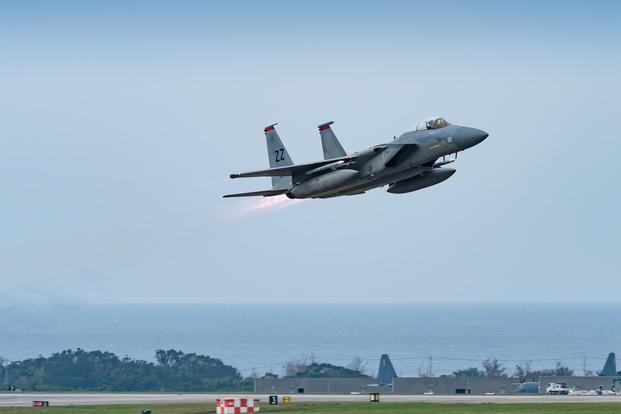An F-15C Eagle from Kadena Air Base, Japan, crashed last year due to a pilot error that caused the fighter jet to spin out of control, according to an Accident Investigation Report released Wednesday.
The pilot, who has not been publicly named, survived the crash but sustained serious injuries, officials said.
Investigators found that an "improper application of the forward stick with full right rudder" resulted in "a negative G departure from controlled flight," according to the report.
Col. Harmon S. Lewis Jr., the Accident Investigation Board president, also determined that "spatial disorientation, lack of emergency procedure training for negative G departures from controlled flight, and limited time to analyze the situation and recover were substantially contributing factors to the mishap."
The F-15, assigned to the 44th Fighter Squadron, 18th Wing, was training with an F-22 Raptor from the 525th Fighter Squadron out of Elmendorf Air Force Base, Alaska, on the morning of June 11, 2018. The two aircraft were over the Pacific for a routine sortie to practice simulated air-to-air missile engagements, according to the investigation.
Related content:
- Thunderbirds Pilot Lost Consciousness Before Fatal Crash, Air Force Says
- Kadena Clears F-15s to Resume Flights After Crash
- Kadena Grounds F-15 Flights After Crash; Pilot in Serious Condition
The pilot in the mishap aircraft was maneuvering defensively in relation to the F-22 at an altitude of about 5,400 feet, and traveling at about 180 knots, or 207 miles per hour, according to the report. Then the pilot initiated a vertical climb, bringing the F-15 to a nose height of 65 degrees, "20 degrees of right bank, 39 degrees Angle-of-Attack," flying at 1.2 Gs.
The plane reached an apex of 6,300 feet, traveling 105 knots or 120 mph, the report stated.
G-force refers to the force of acceleration coupled with gravity, which produces weight on the body.
But the pilot did not feel the plane was flying as desired, and attempted to break the AOA -- or the angle between the reference line of a wing or the airplane itself to the relative oncoming wind -- and get the nose tracking faster during the perceived right turn, the report states.
The pilot forced the plane's forward stick with full right rudder in an attempt to propel the jet in the chosen direction. Instead, the nose "pitched down and to the right to 65 degrees nose low, 110 degrees of right bank, -26 degrees AOA and G-forces decreasing from 1.2 to -0.3 Gs," according to the report.
By entering negative G-forces, or a downward acceleration faster than the rate of natural freefall, the aircraft "experienced a negative G departure from controlled flight with a snap roll entry to the left that transitioned to an inverted, negative G spin," investigators said.
The direct cause of the mishap was the pilot's initial improper application of forward stick with full right rudder, which resulted in the uncontrollable flight "due to the coupling of aerodynamic forces of yaw and roll," the report states.
The roll, or rotation around the front-to-back axis, is most often controlled by ailerons the pilot maintains to move the aircraft to the left or right. The rudder is used to control the yaw, or the rotation around the vertical axis of the plane. On a tail fin, the rudder will swivel from side to side to push the tail in a left or right direction.
The pilot could not recover the aircraft.
Because of the forces pinning the pilot to right side of the aircraft, a first ejection attempt was unsuccessful, officials said. A second attempt was successful, but the plane had lost altitude, forcing the pilot to eject at 1,100 feet.
The F-15C, tail number 84-0008, crashed into the Pacific Ocean approximately 70 miles south of Kadena with a loss valued at $42 million.
Following the crash, Kadena's 18th Operations Group adjusted training standards "to allow for increased decision time for pilots experiencing similar situations," the base said in a release coinciding with the report.
"Also, training and evaluation requirements have been increased on advanced aircraft handling," officials said.
-- Oriana Pawlyk can be reached at oriana.pawlyk@military.com. Follow her on Twitter at @Oriana0214.














